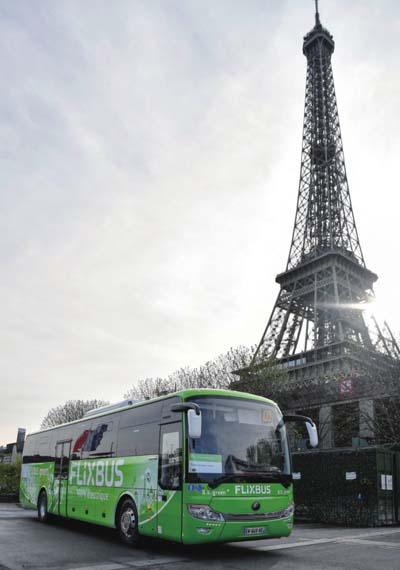Going Electric
2018-10-31ByYuShujun
By Yu Shujun


Shenzhen in south Chinas Guangdong Province is a famous pioneer city of the countrys reform and opening up, transforming itself from a fishing village to a megacity with a population of 12.5 million in the past 40 years.
Today, it is world-renowned for its full-scale adoption of electric buses. In 2017, Shenzhen became the first city in the world with a fully electrifi ed bus fl eet of 16,359 units, the largest as well.
At the 2018 Global Climate Action Summit held in San Francisco in September, Shenzhens e-bus fleet was often cited as an example of zero-emission transportation by participants. During a high-level panel discussion on the topic, Wu You, Deputy Secretary General of the Shenzhen Municipal Government, was invited to share the citys story with leaders of metropolises and states from around the world.
As urban transportation continues to contribute to a growing amount of greenhouse gas and air polluting emissions, electric vehicles(EVs) with zero tailpipe emissions have been widely recognized as a way to improve air quality. The e-buses in Shenzhen consume 72.9 percent less energy than diesel buses and can reduce carbon dioxide emissions by 1.35 million tons and 431.6 tons of other pollutants annually, according to the Shenzhen Municipal Transportation Commission.
A growing number of cities across the globe have adopted e-buses as part of their action plan to fi ght climate change, setting a schedule to switch to all-electric fl eets. Spearheading the trend are Chinese cities like Shenzhen, which, spurred by favorable national policies, are providing an incentive to the global drive.
Worldwide trend
At the summit, states, regions and cities, businesses and investors led the charge on pushing down global emissions by 2020 and setting the stage to reach net zero emissions by midcentury.
A total of 12 regions—including Spains Catalonia, Italys Lombardy, Washington State in the United States and Scotland—representing over 80 million people and over 5 percent of the global GDP, announced that they are committed to having 100-percent zero-emission public fl eets by 2030.
Paul Wheelhouse, Scotlands Minister for Energy, Connectivity and the Islands, said at the Zero Emission Transportation Revolution panel discussion that only 1.1 percent of the Scottish market is ultra-low-emission vehicles, but its seeing a rapid growth of 29 percent a year, far faster than the United Kingdom as a whole.
Leanne Enoch, Australias Queensland Minister for Environment and the Great Barrier Reef, said during the same panel discussion that the state government has established an EV transition strategy, the fi rst of its kind in the country, and is transitioning all the 10,000 vehicles in its bus fleet. The Queensland Government has also built a 1,900-km electric super highway equipped with charging stations, which is the worlds longest in one state.
At the summit, there were 26 cities with some 140 million people committed to buying only zero-emission buses starting in 2025 and creating zero-emission areas in their cities starting in 2030. There were also 23 multinational companies with combined revenue of over $470 billion committed to buying zeroemission fl eets.
To support these EV plans, two big EV infrastructure companies ChargePoint and EVBox announced at the summit their plans to install an aggregate of 3.5 million additional charging points in North America and Europe by 2025.
Faster pace in China
Following Shenzhens example, other major Chinese cities such as Shanghai and Nanjing are on a fast track to fully electrify their bus fl eets. More cities, including many provincial capitals, will join the switch to new-energy buses, mainly e-buses, by 2020, according to a notice on environmental protection and pollution control issued by the Ministry of Transport (MOT) in July. The document also sets a goal of 600,000 new-energy vehicles in public transport for 2020, which include e-buses and e-taxis.
China began launching new-energy vehicles, mainly in public transportation, in 13 pilot cities in 2009. New-energy vehicle manufacturing became a strategic emerging industry in 2010. Since then, the sector has become one of the fastestgrowing, making remarkable contributions to the countrys energy conservation and emission reduction efforts and its fight against climate change, said Zhang Jinhua, Executive Vice President and Secretary General of the Society of Automotive Engineers of China, in a speech at the China Pavilion, a sideline event during the summit.
Generous subsidies from the government and rising demand from environmentally conscious customers have pushed annual production and sales of new-energy vehicles in China to number one worldwide since 2015. Offi cial fi gures show that China is now the worlds largest market for newenergy vehicles with about 1.6 million units, accounting for an estimated 50 percent of total global sales.
China also has an overwhelming majority of the new-energy bus market. A Bloomberg New Energy Finance (BNEF) report shows that in 2017, 99 percent of the 385,000 e-buses on the road globally were in China.
According to data from MOT, at the end of 2017, new-energy vehicles occupied a combined 39.5 percent of Chinas 651,200 buses, with pure e-buses accounting for 26.3 percent and hybrid buses 13.2 percent.
Chinese e-bus manufacturers also dominate the global market in terms of units sold, according to the BNEF report. The two largest e-bus makers, BYD and Yutong, also sell their products to cities in Europe and the United States.
“In North America, we have sold more than 700 electric buses and trucks, more than any other manufacturer,” said Stella Li, President of BYD Motors Inc., during a panel discussion at the China Pavilion. BYD has delivered 35,000 ebuses around the world to date.
Chinese e-buses usually have lower upfront costs compared to those manufactured in the United States or Europe, the BNEF report said. Battery prices in China are now the lowest at both the pack and cell level due to a combination of scale of manufacturing, cheap labor costs, low electricity prices and favorable local conditions, which in turn allows e-buses made in China to be considerably cheaper than those made in the rest of the world, the report explained.
Bumpy road ahead
Despite cities enthusiasm for e-buses around the world, there are factors holding back a rapid global spread.
The e-bus industry is still in its nascent phase, leading to high production costs. Many cities do not have the funds to pay for e-buses due to their higher upfront costs, even with additional support from the government, which is slowing down e-bus adoption, the BNEF report noted. Most of the e-buses on the road in the United States and Europe were bought using national- and regional-level grants, which are not scalable.
Even in China, central government subsidies, which have spurred mass adoption nationwide, have been gradually phased out since 2017 and will be fully ended after 2020, weakening the cost advantages of EVs.
“The upfront costs of e-buses will have to fall and become more competitive with diesel buses for the industry to mature,” said the BNEF report. “Until then, financing options will play an important role.”
Costs of charging facilities and installation, as well as the lack of charging infrastructure standardization are also considered major barriers by many cities.
As major energy companies have committed to building millions of charging points to support e-bus adoption, costs may be driven down. However, “fragmentation of standards often locks bus operators into one e-bus manufacturer or forces additional infrastructure investments, if they decide to change bus suppliers,” the report added.“This reduces competition.”
“Cities would do well to work collectively with national governments to push for the adoption of global standards,” it suggested.
E-buses, with zero emissions and much less noise, can help cities meet their climate and air quality goals, but the industry still has to address emission issues.
“If you generate the electricity that youre using to charge the batteries in those electric cars from coal, youre worse off,”said Michael Bloomberg, the UN Secretary Generals Special Envoy for Climate Action, during a press conference at the summit, citing Indias program of making all cars electric by 2030.
“There are no simple solutions to some of these problems. Theyre long term. We have enormous industrial pressures in infrastructure that we cannot wipe out overnight,” Bloomberg said.
